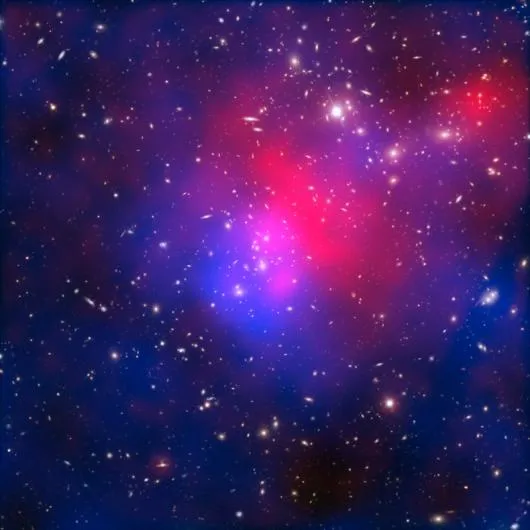Chile’s Elqui Valley hides a secret door to the stars.
A narrow highway heads east through the region’s fertile carpet of green dedicated to producing grapes for both wine and Chile’s famous Pisco brandy.
I found myself making my way along a dirt road beside one of the region’s many vineyards.
After using the proper paperwork to pass through the checkpoint, I travelled along 20 miles of mountain passes to the summit of Cerro Pachón.
Here is the Gabriela Mistral Dark Sky Sanctuary, which numbers among the darkest and driest places on Earth.

On a mountain ridge 2,700m above sea level is the new home to one of astronomy’s most important new facilities, the Vera C Rubin Observatory.
It’s been taking shape here since 2015 and, from 2025, is set to change astronomy forever.
Rubin Observatory is not alone on the mountainside.
A few miles before the ridge is a turn-off to the Cerro Tololo Inter-American Observatory, while just beyond it is the 8.1-metre (26.5ft) Gemini South telescope.
Beyond that, the 4.1-metre (13.4ft) SOAR (Southern Astrophysical Research) telescope.
It’s a breathtaking place to be – in more ways than one, thanks to the thin air at such altitude.
Even getting out of the car too quickly was enough to make me dizzy.
Like another recent arrival, I’d come to take a look around.
But while I was here to explore the observatory, this new addition will be the one taking in the night sky above.

The camera
In late May this year, the world’s largest camera arrived at the Rubin Observatory.
The camera has taken a decade to build at the SLAC National Accelerator Laboratory, California.
It’s about the size of a car and cost $168 million (£132 million), funded by the US Department of Energy’s Office of Science.
With a 64cm-wide (2ft) focal plane covered in 189 individual 16-megapixel CCD sensors, its images will be a whopping 3,200 megapixels.
A single image taken using this camera is large enough to fill 378 4K ultra-HD TV screens.
That level of detail is essential because the telescope’s field of view will be 9.6 square degrees, seven times wider than the diameter of the full Moon.
It adds up to a vast ‘eye on the sky’, whose power is equivalent to seeing a golf ball from about 24km (15 miles) away.

The telescope
At the heart of the Rubin Observatory sits the Simonyi Survey Telescope.
The team at the observatory are preparing the telescope, ensuring everything is in place for the largest astronomy camera ever built to be mounted on it in November 2024.
The camera will record the sky as part of the Legacy Survey of Space and Time (LSST), a hugely ambitious project to produce the largest astronomical movie of all time.
"It’s going to image the whole southern sky once every three to four nights, taking around 800 30-second exposures per night," says Sandrine Thomas, deputy director for Rubin construction for AURA, which operates and builds observatories on behalf of the US National Science Foundation.
"By the end of the 10-year survey, we’ll have about 800 observations of each 9.6-square-degrees field of the southern sky.
After each 30-second exposure, it will move to the next field in five seconds, so from the beginning of one exposure to the next is only about 39 seconds."

The science
The speed and accuracy of the survey will allow astronomers to study the Universe as it changes in real time, from night to night.
This is time-domain astronomy, the study of sources of light that vary over time. That includes events that appear and fade over seconds, hours, days or even years.
It’s here primarily to probe some of the Universe’s biggest mysteries, notably the nature of dark energy and dark matter.
The same dataset will be uniquely suited to a broad range of other astronomy too.
By the time the LSST project is over, it will have catalogued about 40 billion celestial objects, including interstellar comets and asteroids, free-floating stars, billions of galaxies and millions of supernovae.
"Only a handful of supernovae have ever been observed in our galaxy, but LSST will be a supernova factory," says Leanne Guy, data management scientist at Rubin Observatory.
"We'll also detect over 60% of all potentially hazardous asteroids that are larger than 140 metres (460ft)," she enthuses.
"It will be revolutionary for science."

How it will observe
For once, this is not a new observatory you can judge by the size of its mirror.
With an 8.4-metre-diameter (27.5ft) primary mirror, the Simonyi Survey Telescope has a smaller light-collecting area than Hawaii’s Keck Observatory, and even Rubin’s near-neighbour, Gemini South. But comparisons are moot.
"What is so very special about Rubin is its étendue," says Guy.
Étendue is French for 'extent' and describes an optical system in terms of both its light-gathering ability and its field of view.
"It’s absolutely massive. An order of magnitude higher than any other telescope," says Guy.
It’s that uniquely high étendue that will allow Rubin to survey the sky so rapidly and deeply, something that neither Keck nor Gemini South could even attempt.
A limitation of all telescopes is what astronomers call ‘seeing’. It’s the degradation of the image of an astronomical object due to the air mass and the turbulence of the air.

If you’ve ever used a telescope at home and noticed that a planet can look fuzzy one day and clear the next, you’ve already experienced it.
Telescopes with a narrow field of view can correct for this using adaptive optics, but that doesn’t work over a wide field of view like Rubin’s.
Instead, the Rubin team reduced the effects of seeing by choosing a site where the atmosphere has as little impact as possible.
"We need a site with a calm atmosphere and low cloud coverage," said Thomas.
Cerro Pachón is also not on many flight paths, so there are rarely contrails from planes to worry about.
The result is the highest possible number of what astronomers call photometric nights – clear, transparent skies with no visible clouds.
AI takes control
If the camera is Rubin’s heart, its brain is an artificial-intelligence-powered scheduler, which determines where to look and what filters to use, based on the current state of the sky and the scientific output that’s needed.
With just 39 seconds between each exposure, there’s no time for people to be involved, so every tiny movement of the telescope is entirely planned by the scheduler.
"It’s a reward-based system, where the reward is open shutter time," says Guy.
"We know the Moon’s phases, but it has other information coming in from the weather systems and engineering systems, and it can keep changing its plan, but it’s got enough intelligence to know where else to go to maximise open shutter time."
What that scheduler cannot do, however, is any data processing.
The LSST will produce 800 images each night in six wavelengths, from ultraviolet to near-infrared, thanks to its huge filters and filter wheel.
The nightly data will total 20 terabytes, but there’s nothing on the mountaintop that can tell if it has just imaged a supernova going off or not.
Remarkably, just seven seconds after an image is recorded on Cerro Pachón it will have travelled down the mountain via a fibre optic network at speeds of 100GB per second, eventually arriving at a data centre at SLAC.
Algorithms galore will be applied to it and within 120 seconds of it being taken, supercomputers can compare it to a reference image, identifying if anything has changed.
"The goal is to see if there’s anything new in that part of the sky that has changed in position or brightness or that has moved," says Guy.
"This could be an asteroid, a meteor, a comet, a supernova or a transient object."

Alerts
If something is identified, an alert with the sky position and brightness is sent to the global astronomical community.
Astronomers can then request time on other large telescopes to study that new object. There is, however, a problem.
"We will produce 10 million alerts per night," says Guy, who thinks that every image could produce 10,000 alerts.
These will first have to be sorted and processed by software systems before being flagged to astronomers.
"You can’t follow up on every one of those, and most of these will simply be variable stars, but some will be interesting – some will be supernovae."
Once the camera is mounted later this year, the entire system will be tested starting January 2025, with the telescope aligned and the mirrors adapted to make images sharp.
After a short commissioning survey, the LSST will begin at the end of 2025 or the beginning of 2026, commencing Vera Rubin’s quest to sweep the sky night after night.

Exploring the dark Universe
Dark matter is the mysterious substance that appears to thread through our Universe, holding it together with its gravity.
We can’t see it, but we can detect its influence.
Over time, the LSST will build up a deep, detailed map of the cosmos that astronomers will examine for signs of dark matter.
One way it will do this is by looking for signs of weak gravitational lensing.

As light from a distant galaxy travels through the Universe, it passes ‘clumps’ of dark matter, the gravity of which bends the light’s path slightly.
This leaves distortions in our view of the cosmos, which astronomers can pick apart to build a map of dark matter structures throughout the entire Universe.
This in turn will help them examine dark energy, the strange force driving the cosmos apart and accelerating the expansion of the Universe.
As the light of distant objects takes so long to reach us, we’re seeing them as they were in the past.
The depth of the LSST’s map means it will reveal the distribution of dark matter not just across the night sky, but how it’s changed through time.
Cosmologists will be able to analyse this to learn more about how dark energy has shaped our Universe.
This article appeared in the August 2024 issue of BBC Sky at Night Magazine
